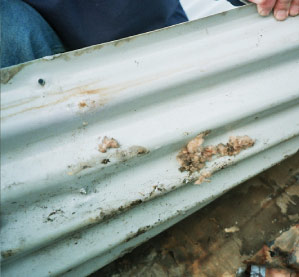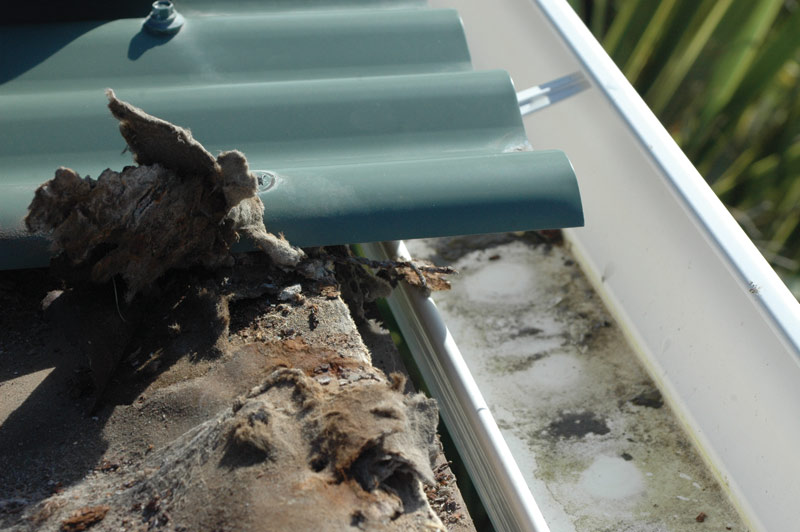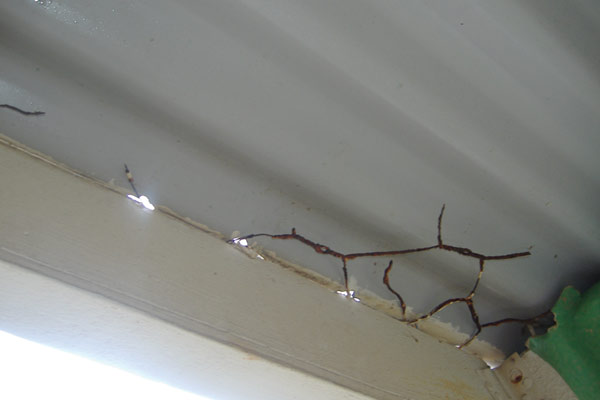Avoiding The Problem Is Easier Than Finding It
Stuart Thomson, recognised for his vast knowledge on the use of metal and principle author of the COP illustrates the benefits of using the COP. How it can save endless hours in tracking and solving problems that should just never happen with “best practice”. As illustrated the time and cost involved in finding and rectifying problems is huge....but aviodable. Professional training starts out with theory and ends up with practice, after all we would rather our doctor or architect did not practice on us first. It seems that trade training is now the other way around.
Professional training starts out with theory and ends up with practice, after all we would rather our doctor or architect did not practice on us first. It seems that trade training is now the other way around.
The mixture of theory and practice is what we term experience. That’s why we called the COP ‘
a living document’. One that will be updated and changed in the light of experience.
The NZMRM Code of Practice has become the basis for theoretical and practical roofer training, now made even more accessible by the publication of the V2 CD.
Revitalized trade training includes a new ITO curriculum for training to National Certificate level based on the COP and placing greater awareness on knowledge.
One of the reasons for discussing this refers to section 7.11. in the COP. FIXING ALUMINIUM SHEETING. Currently under review.
Aluminium does not rust and so the issue is tracing the cause of corrosion on some aluminium sheeting. I was asked to do a Crime scene Investigation into why a roof was leaking because no one could find the culprit..
Murder mystery stories are popular. The reason is the intellectual capacity needed to analyse the evidence, weight it for importance, look for the unusual, in other words ‘get clued up’. The situation of leaky buildings, leaky roofs, or noisy roofs is very similar.
There is the victim (the building), the crime (the defect), and a long list of suspects - the design, the materials, the installation, the construction details, and the environment.
The solution is arrived at by gathering information. This is the theory part.
Then there is the process of elimination and deduction. This is the experience part.
In the course of this process a number of things have to be
kept in mind:
- Forget what other people say and even your own first impressions. A problem must not be approached with preconceived ideas.
- All the defects may not come from the same cause.
- Information that is given must be treated with caution and must always be checked
- Don’t jump to conclusions- a crack is often a symptom not the cause.
- Construction drawings should not be accepted as a true representation of the actual ‘as-built’ construction.
- It is just about impossible to ascertain the facts without invasive investigation. You have to take the roof or wall off n
There have been many instances in the ‘leaky homes’ syndrome where faulty or inadequate diagnosis has resulted not only in the problem not being effectively resolved but where inappropriate action has aggravated the situation.
Recently a WHRS inspector hired a high pressure water-blaster because he could not find the leak! (It was condensation)
The CSI example:
The Brief : A corrugate painted aluminium roof leaking after 15 years.
The facts: Building: Two-storey residence with multiple roofs, the majority being skillion with a roof pitch of 260.
The Site: A very exposed sea-coast site in Wellington across the road from breaking surf
The Design: Laid in accordance with the architects plans and specifications
The Roof: 0.7mm corrugated PVF coated aluminium roof, fixed with stainless steel annular groove nails, laid at the end of 1991.
The Underlay: ‘Non-breather type’ on galvanised wire netting support.
The crime: Small perforations in the valleys of the corrugate profile approximately 200mm and also 700mm from the bottom end of the sheeting.
The Installation: Supplied and laid by a company no longer trading.
The Evidence: Areas worst affected were at the gutter line and adjacent to a flat roof.
The Investigation: Photographic record of roof sheets, underlay and, wire netting removed, samples of all of these were taken for analysis.
The Detailed analysis:
Sheets - underside of sheets showed pitting which when viewed under magnification provided evidence of a pattern pitting that originated from the underside. The laps were also pitted.
Netting - the wire netting was severely rusted and had totally disintegrated in the roof end/gutter area. The aluminium was more seriously attacked where it was in close contact with the galvanised wire netting which had corroded to red rust.
Underlay – totally disintegrated and delaminated in the affected area. Damp to touch in the upper areas.
Ventilation – No air gap under underlay, purlins were cut-in between the rafters and insulation placed between them hard up to the underlay; ventilation was inhibited.
Eave - open ends of profile at
the eave, which allowed air access to the underside of the profile. Some sand had been driven up underneath and accumulated at the profile valley which could also retains salt and can cause abrasion.
So now we have the facts of the matter – the clues, we have to put the theory and practice together and use the deduction process to find out what went wrong. It is easiest to work backwards.
The small holes on the valleys of the profile were all pits but only at specific points. The points coincided with the cross-over of the wire netting – the point of contact where the wire netting had lost its galvanised protection and rusted away. The reason for the rusting of the wire was the salt laden air which had access to the underside of the sheeting because there were no baffle flashing to prevent it entering the ends of the corrugations.
Aerosol salt is one of the most corrosive contaminants that the building industry has to contend
with. This specific environment corresponded to ISO 9223 and AS/NZS 2728: 2007 Category E
Very High, Marine – beach front and surf beaches but can extend inland several hundred metres - formerly AS/NZS 2728: 1997 C5 was Very Severe Marine 0-400m from surf and offshore.
No 1 suspect – salt.
If you are not technically inclined then you can cheat and turn to last page and see who really committed the murder, or else you could bring up the COP. Excerpts from the COP are in italics.
2.4.3.
For corrosion to occur at all there has to be moisture or an electrolyte present ....
Electrolyte: A solution such as water that contains ions, thereby becoming electrically conductive.
2.4.7. Galvanic corrosion acts in a similar way to the process of electroplating....
2.4.8.
Moist air, absorption or thin water films or condensation all can...
A continually moist surface on the underlay and the underside of the aluminium roof sheet.
Why did the underlay remain wet?
No 2 suspect – ‘time of wetness’
4.6.
The amount of ventilation required for domestic, commercial and industrial buildings should be.....
Truss construction with flat ceilings and an attic have a relatively large volume of air compared with skillion roofs which are well known to inhibit ventilation.
No 3 suspect - no ventilation
All underlay underneath metal roof and wall cladding requires three properties – absorbency, permeability and water resistance.
The underlay used on this job was not permeable.
4.3.
The purposes of an underlay as referenced in this code of practice is ...
NZS 3604: 1990 (current at the time of installation) required the use of permeable underlay and it was well known that a permeable underlay was required under all metal roof cladding
It can be deduced that the underlay did not comply with the NZ Standard and also that the technical literature was incorrect as it was not ‘clearly presented’ or adequate as required by NZS 3604.
 No 4 suspect – wrong underlay
No 4 suspect – wrong underlay
The amount of salt within the roof cavity was visibly obvious and the sheeting was ‘crunchy’ to the touch. A large amount of contaminated air entered via the open area of the corrugations, being 50% of the area of the profile. Plastic spouting was lower than the bottom of the corrugations whereas a high fronted spouting would have inhibited air entry.
No 5 suspect – open ends of profile
Some pitting was also observed at the spouting line where a ‘chimney’ gap was seen behind the plastic spouting. This has proved to be the entry point for salt contaminants to the underside of the roof on other sites.
Plastic spouting brackets allow a clearance which can cause corrosion irrespective of any underlay than might be used. This problem is a design issue that can be overcome by using an apron flashing which can become a sacrificial flashing to protect the roof cladding.
This is detailed in COP 5.3.5.4
Where the ends of roof cladding are exposed to contaminants such as sea salt or industrial pollutants it is better practice ...
No 6 suspect – no apron flashing
ARX Aluminium cladding is now promoted as being suitable for very severe marine so why corrosion pitting? The coating used at the time was Colorcote® 8000.
Both Zinc and Aluminium provide cathodic protection to steel and where the underlying steel base becomes exposed at cut edges, holes or mechanically damaged areas, the zinc coating will corrode in preference to the steel. The ability of a hot-dipped zinc coating on steel to protect it against corrosion is known as sacrificial or cathodic protection because the cathode metal (steel) is the one protected.
The three components required for corrosion to occur, (known as the corrosion triangle), are the anode, cathode and the electrolyte. In this case the underlay was acting as the electrolyte as it was almost continually wet either by salt contamination or by condensation from within the cavity.
The wire netting was galvanised but once the zinc had eroded or corroded away the aluminium would become the anode and attempt to provide ‘barrier and cathodic protection’ to the steel.  Aluminium does not ‘rust’ but will pit due to electrolytic action.
Aluminium does not ‘rust’ but will pit due to electrolytic action.
COP 2.6.2. Pitting Corrosion
Pitting corrosion is a form of highly localised corrosive attack that occurs in.....
Because we have a number of suspects, all with evidence against them, it is reasonable to deduce that there is a gang at work and together they committed the crime. Individually guilty – maybe not, but collectively, yes.
Verdict.
The following conclusions can be reasonably drawn from the evidence presented.
The corrosion of the aluminium roof cladding has been gradual since its installation 15 years ago but has accelerated recently. The deterioration of the aluminium roof cladding was caused by a number of separate but inter-related factors.
The corrosion mechanism at this site was divided into several steps. First the saturated underlay provided the electrolyte by being continually wetted by condensation and salt, and the passive oxide film was dissolved due to the interaction with the rusting steel wire netting.
Secondly the aluminium sheeting reacted strongly and created a pit, the bottom of the pit being the anode and the top of the pit being the cathode. The corrosive cycle would have then proceeded according to the electrochemical reaction described.
The corrosion of the galvanised wire netting was not the only reason for perforation as the side laps were also badly pitted but it did provide areas that were more seriously attacked where the red rust at the wire cross-over and the aluminium were in close contact. The underlay contributed to the corrosion by retaining the condensation and salt water vapour to remain wet and due to the ‘time of wetness’ provided the moist contact required for corrosion. The underlay was unsuitable and it should not have been used as a roofing underlay as it was not permeable.
The design combination of skillion roof and ‘cut-in’ purlins inhibited any ventilation which would have occurred had there been an air gap between the underlay and the fibreglass batts.
It is significant that the stainless steel fixings have shown no signs of deterioration or halo around the hole. They were driven without any clearance hole. There was no sign of leakage around any of the fasteners.
The design faults have been identified and the obvious choice would be not to use wire netting or use open profiles.
Not long after this CSI, two members of the NZMRM technical committee, Rod Newbold (Steel & Tube) and David Bullock (Dimond) and Tim Rutt of Pacific Coil Coaters, visited several other properties with similar complaints.
What they found were common factors between their sites and the one quoted.
- Very Severe Marine environment
- Wire netting support.
- Corrugate profile
- Corrosion near to the gutter line (in one instance there was no lining on the verandah eave which had netting and underlay!
When the environment is regarded as very severe, the following Do’s and Don’t’s will ensure the life of metal roof cladding is prolonged.
DO USE:
- A self-supporting permeable underlay and fix with stainless steel staples.
- A minimum 20mm air gap between any insulation and the underlay.
- An eave over-flashing at the gutter.
- A high fronted spouting or baffle flashing at the eave to prevent the entry of salt laden air.
- An extruded polystyrene batten to provide an air gap, with the underlay under the batten.
- A secret-fix profile instead of corrugate
- Aluminium window tape as an isolator over wire netting if the pitch is under eight degrees.
(see also COP 4.3.11.)
DO NOT USE:
- Galvanized wire netting (or safety mesh) as an underlay support.
- Skillion construction without additional provision for ventilation.
- ‘Cut-in’ battens without an extruded polystyrene counter batten to provide an air gap, with the underlay under the batten.
- Copper treated timber in direct contact with the roof cladding, in very severe environments, even with an underlay separation.
NZMRM are conducting an extensive test programme with Aluminium profiled sheeting using different fasteners and different fastening patterns. The results will update the COP and be posted on the NZMRM website.
What we can say at this time is that oversize holes are recommended (which means using load spreading washers) and that the new aluminium fixing screws have passed with flying colours.
